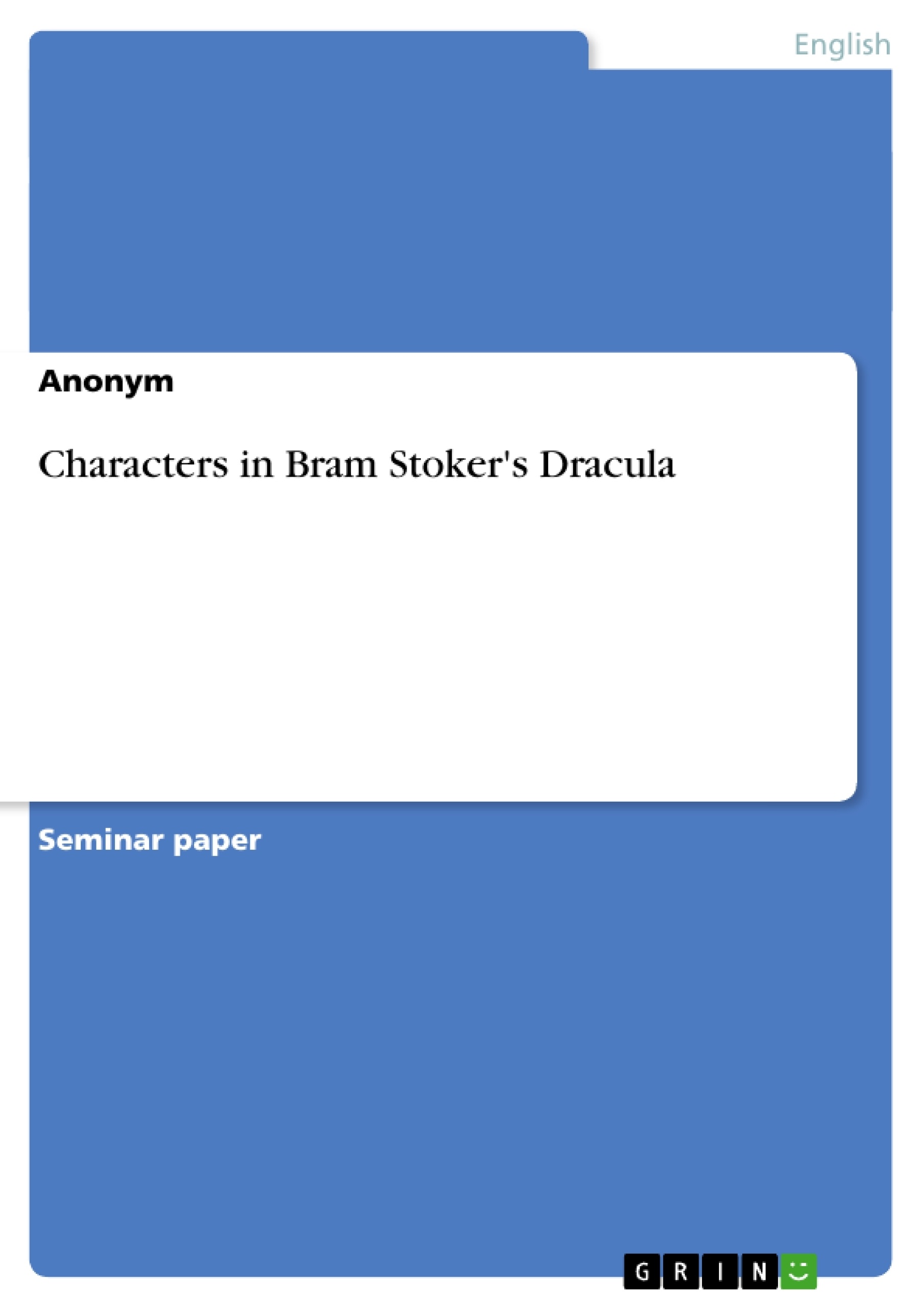When Abraham «Bram» Stoker wrote his novel Dracula between 1890 and 1897, he chose his characters wisely. The horror novel contains eight main characters, only two of them female. The remaining six male figures all play a special role and fulfil a certain stereotype. It is the aim of this paper to display these roles and show how the characters stand in contrast or even resemble each other. Another factor to be analysed is how we get to know the characters in novel. Are they describing themselves ? Do we learn about their traits through their actions ? Or do other characters tell us how they usually behave ?
Table of Contents
- 1. Introduction
- 2. Techniques of Characterisation
- 3. Major Characters
- 3.1. Count Dracula
- 3.2. Jonathan Harker
- 3.3. Mina Murray
- 3.4. Lucy Westenra
- 3.5. Dr. John Seward
- 3.6. Arthur Holmwood
- 3.7. Quincey P. Morris
- 3.8. Dr. Abraham van Helsing
- 4. Minor Characters
- 4.1. R.M. Renfield
- 4.2. Other characters
Objectives and Key Themes
This paper aims to analyze the characterization techniques used in Bram Stoker's Dracula and to examine the roles and relationships between the main characters. It explores how the characters are presented—through self-description, actions, or descriptions by other characters—and how these presentations contribute to the overall narrative. The analysis considers the contrasting and similar traits among characters to understand their individual functions within the story.
- Characterization techniques in Dracula
- The roles and functions of major characters
- Relationships and contrasts between characters
- The use of explicit and implicit characterization
- Dracula's multifaceted portrayal
Chapter Summaries
1. Introduction: This introductory chapter sets the stage for the analysis of characterization in Bram Stoker's Dracula. It highlights the novel's eight main characters, with a focus on the unique roles and stereotypical representations of the six male and two female figures. The chapter outlines the paper's objective: to analyze these roles, the contrasts and similarities between characters, and the methods employed to reveal character traits to the reader.
2. Techniques of Characterisation: This chapter explores the various methods of characterization used in the novel. It differentiates between implicit and explicit characterization, outlining the roles of the narrator (authorial characterization), other characters (figural characterization), and self-characterization. The chapter further discusses how implicit characterization is revealed through actions, thoughts, and appearance, while explicit characterization is achieved through descriptions and direct comments. The concept of contrasting and corresponding character traits is introduced, along with the technique of block characterization, where a character's traits are presented compactly and directly.
3. Major Characters: This section serves as an introduction to the analysis of the main characters, providing a framework for the more detailed character studies to follow in the subsequent sub-chapters. While not offering summaries of the individual character analyses to come, it sets the stage for a deeper exploration into how each character functions within the context of the novel's overall narrative and themes.
Keywords
Bram Stoker, Dracula, characterization, implicit characterization, explicit characterization, authorial characterization, figural characterization, self-characterization, Gothic horror, Victorian literature, character analysis, Count Dracula, Jonathan Harker, Mina Murray, Lucy Westenra, themes, narrative techniques.
Bram Stoker's Dracula: Character Analysis - FAQ
What is the purpose of this document?
This document provides a comprehensive preview of a paper analyzing characterization techniques in Bram Stoker's Dracula. It includes a table of contents, objectives, key themes, chapter summaries, and keywords.
What are the key themes explored in the paper?
The paper explores characterization techniques in Dracula, the roles and functions of major characters, the relationships and contrasts between characters, the use of explicit and implicit characterization, and Dracula's multifaceted portrayal.
What characterization techniques are discussed?
The analysis covers implicit and explicit characterization, authorial characterization (narrator's role), figural characterization (other characters' descriptions), and self-characterization. It also discusses the use of contrasting and corresponding character traits and block characterization.
Which characters are analyzed in detail?
The paper focuses on eight main characters: Count Dracula, Jonathan Harker, Mina Murray, Lucy Westenra, Dr. John Seward, Arthur Holmwood, Quincey P. Morris, and Dr. Abraham van Helsing. It also briefly mentions minor characters like R.M. Renfield.
What is the structure of the paper?
The paper is structured into chapters covering an introduction, characterization techniques, detailed analysis of major characters (each in a sub-chapter), and a discussion of minor characters.
What is the scope of the chapter on "Techniques of Characterization"?
This chapter distinguishes between implicit (revealed through actions, thoughts, appearance) and explicit characterization (through descriptions and direct comments). It explains how character traits are revealed through different perspectives and narrative techniques.
What does the chapter on "Major Characters" cover?
This section introduces the main characters and provides a framework for the more detailed character studies that follow in the subsequent sub-chapters. It sets the stage for a deeper exploration of each character's function within the novel's narrative and themes.
What keywords are associated with this paper?
Keywords include: Bram Stoker, Dracula, characterization, implicit characterization, explicit characterization, authorial characterization, figural characterization, self-characterization, Gothic horror, Victorian literature, character analysis, Count Dracula, Jonathan Harker, Mina Murray, Lucy Westenra, themes, and narrative techniques.
What is the overall objective of the analysis?
The paper aims to analyze the characterization techniques used in Dracula and examine the roles and relationships between the main characters, exploring how character presentations contribute to the overall narrative.
- Quote paper
- Anonym (Author), 2008, Characters in Bram Stoker's Dracula, Munich, GRIN Verlag, https://www.grin.com/document/134859




